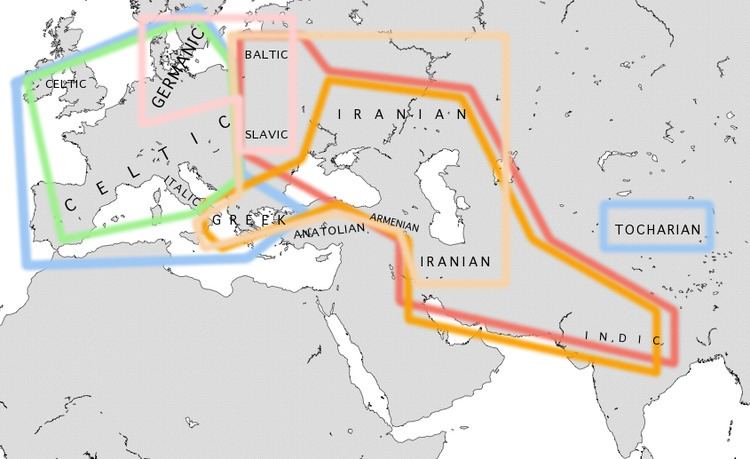 | ||
As the Proto-Indo-European language (PIE) broke up, its sound system diverged as well, according to various sound laws in the daughter Indo-European languages.
Contents
- Consonants
- Consonant clusters
- Vowels and syllabic consonants
- Examples
- p
- t
- k
- Sound laws within PIE
- References
Especially notable is the palatalization that produced the satem languages, along with the associated ruki sound law. Other notable changes are Grimm's law and Verner's law in Proto-Germanic; an independent change similar to Grimm's law in Armenian; loss of prevocalic *p- in Proto-Celtic; Brugmann's law in Proto-Indo-Iranian; Winter's law and Hirt's law in Balto-Slavic; and merging of voiced and breathy-voiced stops, and /a/ and /o/, in various "northern" languages. Bartholomae's law in Indo-Iranian, and Sievers' law in Proto-Germanic and (to some extent) various other branches, may or may not have been common Indo-European features. A number of innovations, both phonological and morphological, represent areal features common to the Italic and Celtic languages; among them are the development of labiovelars to labial consonants in some Italic and Celtic branches, producing "p-Celtic" and "q-Celtic" languages (likewise "p-Italic" and "q-Italic", although these terms are less used). Another grouping with many shared areal innovations is Greek, Indo-Iranian, and Armenian; among the common phonological innovations are Grassmann's law in Greek and Indo-Iranian, and weakening of pre-vocalic /s/ to /h/ in Greek, Iranian and Armenian.
Consonants
The following table shows the Proto-Indo-European consonants and their reflexes in selected Indo-European daughter languages. Background and further details can be found in various related articles, including Proto-Indo-European phonology, Centum and satem languages, the articles on the various sound laws referred to in the introduction, and the articles on the various IE proto-languages, language groups and language phonologies. For development of the laryngeals and syllabic consonants, see the vowels table below.
Notes for table 1:
Consonant clusters
Proto-Indo-European also had numerous consonant clusters, such as *st, *ḱs. In most cases in most languages, each consonant in a cluster develops according to the normal development given in the table above. Many consonant clusters however also show special developments in multiple languages. Some of these are given by the following table (with cases of otherwise predictable development in gray):
Notes to Table 2:
Notes:Vowels and syllabic consonants
This table shows the Proto-Indo-European vowels and syllabic consonants (as reconstructed both before and after the acceptance of laryngeal theory), and their reflexes in selected Indo-European daughter languages. Background and further details can be found in various related articles, including Proto-Indo-European phonology, the articles on the various sound laws referred to in the introduction, and the articles on the various IE proto-languages, language groups and language phonologies.
Examples
See the list of Proto-Indo-European roots hosted at Wiktionary.
*p
*pṓds, ~ *ped-, "foot".
*t
*tréyes, "three".
*ḱ
*ḱm̥tóm, "hundred" (from earlier *dk̂m̥tóm)
*k
*kreuh₂, "raw flesh"
Sound laws within PIE
A few phonological laws can be reconstructed that may have been effective prior to the final breakup of PIE by internal reconstruction.
